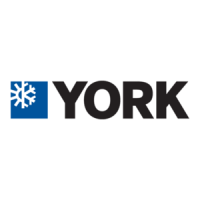
Do you have a question about the York FG8 SERIES and is the answer not in the manual?
Highlights critical safety warnings regarding improper installation, compliance, and furnace area usage.
Details national and local codes for furnace installation, including NFGC and NEC.
Describes installation positions for 50-125 MBH models: upflow, downflow, or horizontal.
Specifies installation positions for 150 MBH models: upflow or horizontal.
Step-by-step guide to convert furnace from downflow to upflow configuration.
Step-by-step guide to convert furnace from upflow to downflow configuration.
Details minimum required clearances from the furnace to combustible materials for various configurations.
Guidelines for providing combustion air in confined spaces, including opening size requirements.
Describes combustion air requirements for unconfined spaces and tight construction buildings.
Adherence to ASHRAE/NFPA 90 and local codes for duct system design is crucial for performance.
Methods for integrating cooling coils with the furnace, including safety precautions for dampers.
Specifies acceptable continuous return air temperature range for furnace operation.
Details on connecting return air ducts for upflow, downflow, and horizontal setups.
Emphasizes filter necessity for system efficiency and equipment protection.
Procedure for determining and verifying gas input rate, including high altitude adjustments.
Guidance on proper sizing of the vent system for the furnace using NFGC tables.
Rules and considerations for venting into existing masonry or B-1 lined chimneys.
Instructions for field wiring, polarity, and wiring diagrams for thermostat and accessories.
Requirement for proper electrical grounding of the furnace casing according to codes.
Guidance on wiring electronic air cleaners and humidifiers to the furnace control board.
Instructions for wiring two furnaces to operate simultaneously using a common duct system.
Explanation of heating on/off delays and how to adjust the blower off delay timing.
Interpretation of diagnostic light flashes to identify furnace fault conditions and troubleshooting.
Crucial safety guidelines for operating the furnace, including gas leak detection and response.
Table showing proper gas orifice sizes for various altitudes for natural and LP gas.
Procedure for measuring air temperature rise and its importance for furnace performance.
Information on motor lubrication, burner cleaning, and flue gas passageways.
Guidance on ordering genuine authorized replacement parts for the furnace.
